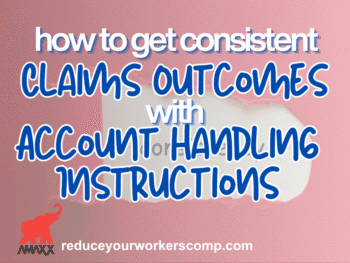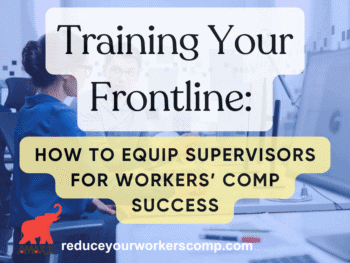No matter what season whether it is winter, spring, summer, or fall, it is some company's “busy” or peak season somewhere. Unfortunately for niche businesses, this peak time can also be a prime time for workers compensation injuries.
New staff is hired to meet the upcoming demands, and the company employees are working longer hours to meet the demand. The equipment begins to require more maintenance and repair during this “busy” period. It is imperative not to forget about workplace safety during this time. Here we discuss a few ways to curb the exposure to injuries.
1. Solid hiring practices
When demand is high for the work product, it is easy to forget focusing on important aspects of the business. The peak time of year means hiring new full time and part time employees. These employees may be referrals from other employees or simply walk in with little to no experience.
Evaluating the job candidates is critical. On average, first-year employees have a higher incidence of injuries than more experienced or tenured employees. This may sound obvious, but hiring practices are key in preventing workers compensation injuries. Workplace safety must be part of the screening process as well as physicals and drug screens prior to hiring. Monitor the potential employee’s attitude toward safety during the interview process and while touring the workplace. The way the employee behaves during this time could be a sign of carelessness that could lead to a workplace injury. (WCxKit) One company had 80% of injuries occuring to employees with less than one year's tenure.
2. Proper orientation and safety training
Safety comes first and the facility should maintain safety at all times of the year. Focusing on safety only during a peak time is ineffective and potentially hazardous. Protocol for repairs, maintenance, and inspections should happen consistently throughout the year.
Employees should be reminded about safe work practices and be trained in proper safety techniques. Emergency procedures, safe work practices, protective equipment are key to preventing injuries during the peak time and anytime of the year. Mock injury set ups can be educational and reveal how employees will respond in an emergency situation. Having a plan in place will help employees know how to respond properly and effectively should an injury occur.
3. Proactive and involved supervision
Supervising and enforcing safe work practices is a key component to reducing the risk of injuries. Every employee is responsible to work safely, even if it is not the easiest and fastest way. Managers and supervisors onsite should be aware of an employee's every move. Operational guidelines such as proper guards for saws and safety glasses are crucial. If a supervisor catches an employee working unsafely, the employee must be disciplined. Employees will only take safety seriously, if there are serious and automatic consequences.
The employee should be allowed to provide feedback keeping the lines of communication open. Employees are not prisoners, and employees most likely has ideas on how to change workstations to increase safety standards. Providing incentives like raffles for free gas cards is an easy option. A supervisor can implement a new safety technique and the results will travel to senior level management. By giving the employee a chance to weigh in, work safety techniques will be more successful overall.
4. Super fast accident response
As mentioned above, employees must understand what to do should an accident occur. If an employee using a saw cuts a hand and tells a supervisor about the accident, the supervisor will then tell the HR person and take the employee to receive medical care. The first report of injury is completed and called in to the insurance carrier. The employee returns to the shop bringing the medical slip to the HR person, who then faxes or emails the adjuster. Within 24 hours, the adjuster already has the injury report, statements from the supervisor and HR, and the medical slip. These items are crucial to a claim being handled properly after an accident.
This example may sound like workers compensation 101, but it is surprising how many employers do not stick to this process. Having a proper procedure in place following an injury prevents a delay. And any delay affects wage payments, medical coverage, and a return to work. Take time to have a step by step process and mock injuries, so that when an actual injury occurs, everyone knows exactly what to do. (WCxKit)
Summary
Peak work seasons elevate the exposure on many levels. With proper hiring practices, solid orientation, thorough training, proactive supervision, and fast accident response, and reporting everyone knows how to respond to an injury in the workplace. It sounds simple, but practice makes perfect. Do not wait until an injury happens to figure out how to handle it.
Author Rebecca Shafer, JD, President of Amaxx Risk Solutions, Inc. is a national expert in the field of workers compensation. She is a writer, speaker, and website publisher. Her expertise is working with employers to reduce workers compensation costs, and her clients include airlines, healthcare, printing, publishing, pharmaceuticals, retail, hospitality, and manufacturing. See www.LowerWC.com for more information. Contact: RShafer@ReduceYourWorkersComp.com.
Our WORKERS COMP BOOK: www.wcmanual.com
WORK COMP CALCULATOR: www.LowerWC.com/calculator.php
MODIFIED DUTY CALCULATOR: www.LowerWC.com/transitional-duty-cost-calculator.php
SUBSCRIBE: Workers Comp Resource Center Newsletter
Do not use this information without independent verification. All state laws vary. You should consult with your insurance broker or agent about workers comp issues.
©2011 Amaxx Risk Solutions, Inc. All rights reserved under International Copyright Law. If you would like permission to reprint this material, contact Info@ReduceYourWorkersComp.com.


















